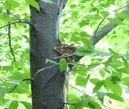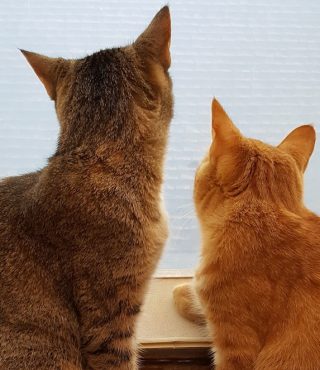Wood Thrush Species Profile

The Wood Thrush has rusty-brown upperparts with distinct, black spots on its white underparts. It is slightly smaller than the American Robin and has a similar shape, because of its short tail, straight beak, and pot-bellied body. It has white eye rings and a loud, flute-like call. It breeds in deciduous and mixed wood (coniferous-deciduous) forests in southeastern Canada and eastern United States, and overwinters in Central America. Their habitat includes tall trees, dense patches of lower shrubs or saplings for nest sites, water nearby, and a moist forest floor with abundant decaying leaf litter. It forages on the ground in the leaf litter for invertebrates, such as snails, beetles, caterpillars, and spiders and builds its nest in a variety of locations from low shrubs and saplings to the crotch of a tree branch. The nest is built out of stems, leaves, and dead grass.

Figure 1: Wood Thrush nest photo by Ted Cheskey
In Canada, this species is listed as threatened by the Committee on the Status of Endangered Wildlife in Canada (COSEWIC). The population declined 62% between 1966 and 2015. Wood Thrush face a variety of threats that contribute to its decline, including habitat fragmentation on its breeding grounds, habitat loss on its wintering grounds, and acid rain depleting invertebrate prey. Further, they’re vulnerable to nest parasitism (a non-mutual relationship between species) by Brown-headed Cowbirds. Brown-headed Cowbirds lay their eggs in Wood Thrush nests, using the Wood Thrush as a surrogate parent. This takes away from the time and energy the Wood Thrush can give to its own young. Also, over-browsing by White-Tailed Deer threatens Wood Thrush habitat because it decreases the abundance of understorey vegetation. Lastly, because they forage on the ground and nest near the ground, they are vulnerable to cat predation.
Two easy ways you can help this declining species is to buy shade-grown, bird-friendly coffee and keep your cat from roaming unsupervised. Buying shade-grown, bird-friendly coffee supports bird conservation because this method of farming preserves critical habitat in the wintering zone for the species, and keeping your cat from roaming unsupervised reduces predation.








